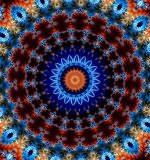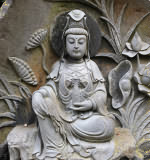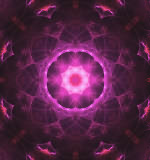| Töltsd le és telepítsd a nélkülözhetetlen betűtípusokat(s) Hogy megtekinthesd a Szanszkritot annak teljes fényében Olvass Transzliteráció (2) (magyar) hogy teljes mértékben átlásd a transzliterációs rendszert |
Tanulj Szanszkritul - Első Lépések (3)
Haladj tovább a Szanszkrit nyelv ismeretében és filozófiáiban - 2. rész
Introduction
Hi, Gabriel Pradīpaka again. In this document we will go deeper into two important subjects. Firstly, I will speak of what each philosophical system considers to be "Enlightenment". Lots of people talk about Enlightenment but they do not know what Enlightenment actually is. Every "darśana" (philosophy) has a different viewpoint about it. The whole thing is not so easy as some people could think. Finally, I will teach you more things about Sanskrit language and Yoga.
One more thing, Tattvic Chart is indispensable to understand the core of the teaching to be given by me now. Go to it from time to time for additional information. Let us get down to work.
What is Enlightenment according to the six traditional philosophies and Trika?
The Enlightenment is the goal in all philosophical systems of India. But, what does it mean according to each of them? This is an interesting question which we will study together. Well, let us begin:
The six traditional philosophies are Āstikadarśana-s, that is, they consider the Veda-s to be the infallible source of spiritual knowledge. These six orthodox schools may be divided into two groups: (1) schools directly based on the Veda-s and (2) schools based indirectly on the Veda-s, which even so do accept their testimony and attempt to show how their systems are harmonious with the Veda-s. The former are two celebrated philosophies: (a) Vedānta or Uttaramīmāṁsā and (b) Pūrvamīmāṁsā. The latter are four philosophies, two of which (Sāṅkhya and Yoga) are celebrated: (a) Nyāya, (b) Vaiśeṣika, (c) Sāṅkhya and (d) Yoga ("Pātañjalayoga" really, a particular Yoga consisting of eight members or stages, and conceived by the sage Patañjali). Let us start our study with Nyāya and Vaiśeṣika (Go to First Steps (2) and then click on the link "Six traditional philosophies and Trika" for more information):
NYĀYA AND VAIŚEṢIKA
These two schools agree with each other regarding Enlightenment or Liberation. They use the term "Apavarga" to designate Mokṣa or Enlightenment. Apavarga means "escape from pain, the emancipation of the soul from bodily existence which is full of pain". It is a classic "Saccit" (Sat + Cit) school, that is, in the Liberation one experiences "Sat" (infinite existence) and "Cit" (infinite consciousness) alone, but no "Ānanda" or "supreme bliss". So, Apavarga is devoid from pain or pleasure. In fact, it is without any experience whatsoever. According to this philosophical school, one attains to final Liberation by cultivating ethical virtues and obtaining an insight into the nature of the categories or tattva-s (levels of Creation). It is to be noted that the categories or tattva-s listed by Nyāya and Vaiśeṣika are not the same as those of Trika system. Not at all. Nyāya and Vaiśeṣika divide the categories into three groups: Dravya (substance), Guṇa (quality) and Karma (activity). Each of these groups contains a particular number of categories. It is a long study that we will surely undertake in depth later on.
SĀṄKHYA
This school uses the term "Kaivalya" (isolation or aloofness) to designate the Enlightenment. It is a Saccit system, that is, there is no "bliss" in Kaivalya. There is neither pleasure nor pain, just a continuous peaceful state. The process to attain Kaivalya is a long one, no doubt.
I will attempt to concisely explain "one way" to achieve Kaivalya or Enlightenment to you. Of course, it is very difficult to attain it just in one session of meditation, haha! It is a long process despite I am describing it in a few simple steps:
1) First of all, you should be able to make your mind onepointed on a particular object of concentration. When the concentration (Dhāraṇā) is maintained for long, that is known as meditation (Dhyāna). It takes many years to achieve a "real" meditation for a long period of time. If you cannot concentrate your mind in that manner, the second step will turn out to be impossible to be accomplished. Go to our Trika section for more information (please, start your study from Meditation 1 or you will be losing lots of indispensable information).
2) Once you have attained to mastery in meditation, you can attempt to realize the "real essence" of each category or tattva, from the lowest levels to the highest ones. I am going to use a "very small and square" piece of a blue-colored cloth to start with the process of realization. The blue color should be "solid" (no stampings on the fabric please; this is very important to make the concentration easier). There are 25 categories or tattva-s according to Sāṅkhya. It is to be noted that the 25 categories or tattva-s postulated by Sāṅkhya are the same as the last 25 categories of Trika (Non-dual Shaivism of Kashmir). In fact, Trika just added 11 more categories to the 25 of Sāṅkhya. That is why the Trika's levels of Creation are 36 in all. Actually, we could say that the doctrine of the 36 categories is a kind of reworking of the 25 categories of Sāṅkhya. Trika does not deny the teachings of Sāṅkhya, but rather it expands them... however, this is "another" long topic that we will undoubtedly study later on:
(1) Puruṣa (spirit), (2) Prakṛti (undifferentiated matter, the source for all matter), (3) Mahat or Buddhi (intellect), (4) Ahaṅkāra (ego); [the group of Jñānendriya-s or powers of perception is formed from the tattva-s 5th to 10th --note that the "mind" or Manas is included--] (5) Manas (mind), (6) Śrotra (power of hearing), (7) Tvak (power of feeling by touch), (8) Cakṣus (power of seeing), (9) Rasanā or Jihvā (power of tasting), (10) Ghrāṇa (power of smelling); [the group of Karmendriya-s or powers of action is formed from the tattva-s 11th to 15th] (11), Vāk (power of speaking), (12) Pāṇi (power of handling), (13) Pāda (power of locomotion), (14) Pāyu (power of excreting), (15) Upastha (power of sexual activity and restfulness); [the group of Tanmātra-s or subtle elements is formed from the tattva-s 16th to 20th] (16) Śabda (sound-as-such), (17) Sparśa (touch-as-such), (18) Rūpa (color-as-such), (19) Rasa (flavor-as-such), (20) Gandha (odor-as-such); [the group of Mahābhūta-s or gross elements is formed from the tattva-s 21st to 25th] (21) Ākāśa (ether or space), (22) Vāyu (air), (23) Agni or Tejas (fire), (24) Āpas (water) and (25) Pṛthivī (earth).
Well, sit down now and place that piece of blue cloth right in front of you on the ground. You surely wonder why I am saying that you should use a colored cloth to concentrate your mind on. Look, to realize the real essence of every category, you must start your practice with one of the Mahābhūta-s (the last five tattva-s). You "must" choose one of them: ether or space, air, fire, water or earth. It is "generally" much easier to concentrate one's own mind on something by using the power of seeing. You might use the power of smelling, for example, to concentrate your mind on a particular odor, but it will be somewhat difficult for some people to do this for a certain period of time. So, although I am using the eyes in this example, you may readapt the practice and use a sound, a touch, a flavor or even an odor, if you wish. The presence of fire (Agni or Tejas) in the cloth is the cause for its color. Thus, if you gaze with an onepointed mind at the cloth, you will be concentrating on Agni or fire. Do it!
If that concentration is sustained for a long time, you will find that the cloth will appear to fill the entire field of vision. Now you are not conscious of any other object apart from the cloth. When your field of vision is filled with the blue-colored cloth, you realize the "real essence or nature" of Agni or fire. It takes time to attain that degree of concentration though. Be patient and do not become disappointed "if you cannot achieve it at once", haha!
Once you attain that state in which the cloth appears to fill the entire field of your vision, focus your attention on a fraction (a half, firstly) of that blue-colored cloth that now, as I said previously, appears to fill the entire field of vision. You must keep concentrating your mind on that fraction till it will appear to grow and fill the entire field of vision. Then, you must focus your attention on a fraction of that fraction, that is, 1/4 of the original cloth. Again, you keep your mind concentrated on that area till it will grow and fill the entire field of vision. Continue to reduce the area of concentration in that way (1/8, 1/16, 1/32, etc.). Finally, when the area of concentration is too small to be reduced again, you will realize that a gradual state of stillness begins permeating your mind and power of seeing. The reason is the following: for the optical activity to work, the power of vision needs "something to see". As the area of concentration is so "tiny", the "optical fuel" is about to run out and consequently the power of vision is about to come to a stop. Good, just before the stoppage of the power of vision and the subsequent fading out of all knowledge in respect of Agni or fire (color and heat), the eyes can transmit only the subtlest trace of sensation necessary for cognition. And this is the Tanmātra known as Rūpa (color-as-such). The Tanmātra-s are named "as-such" because they are the patterns which make the sensory perception possible. They have no qualities and therefore they are elements "as-such". So, Rūpatanmātra (tattva 18) is the subtle knowledge of Agni or fire (the blue color in the cloth) brought about by the minimal quantity of "optical fuel" in the form of "blue color", in this case.
As I said, it takes a long time to accomplish the entire process, but the resulting fruit is worth striving for. You are no longer a slave of your eyes and mind behind, because you have fully realized the essence of all that contains color and heat in the universe, that is, Agni or fire. You do not need to do a similar practice for each of the remaining Mahābhūta-s, but if you wish, do it. Even though you attain complete control of fire through this practice, your goal must not be to acquire mere inferior powers on the elements but to achieve realization of the Reality behind this universe. Sāṅkhya states that Puruṣa is that final Reality which you will achieve by using the process I am teaching you.
3) From this point, you undertake the realization of the Indriya-s composed of Jñānendriya-s (5th to 10th tattva-s, including Manas or mind) and Karmendriya-s (11th to 15th tattva-s). To realize the Indriya-s (Cakṣus or power of seeing --tattva 8-- in this case), do the following: When the senses, through which the Indriya-s work, become completely still due to your realization of the Tanmātra-s, the ego or Ahaṅkāra (tattva 4) withdraws from them. When this happens, you come to realize that all those Indriya-s are permeated by Ahaṅkāra and that Ahaṅkāra itself its the ultimate cause for the process of cognition. According to the example we are developing, after the realization of Rūpatanmātra, you come to understand that your own power of seeing or Indriya named Cakṣus (that is, Cakṣurindriya), with which you perceived the aforesaid Tanmātra, is pervaded by Ahaṅkāra or ego. A supreme bliss invades your entire being when you realize Indriya-s, because you understand that Jñānendriya-s and Karmendriya-s are merely the channels used by the ego for its coming into contact with the external world. You do not need realize each Indriya individually. In this example, your realization of Cakṣurindriya (power of seeing) would be enough. From understanding the real nature of Indriya-s, many powers come to you: clairvoyance and the rest of "clair" powers associated with every Indriya.
4) The apprehension of Ahaṅkāra or ego (tattva 4) involves the following procedure: After recognizing that the Indriya-s are absolutely permeated by Ahaṅkāra (I-sense), you direct your attention to the ego itself. All mental processes have been stopped, and you only abide in that I-sense. This is Ahaṅkāra realization. You fully understand that the entire process of the world has emerged from the ego and that it will be lastly dissolved in that very ego (its source) again.
5) Next, you get to Buddhi or intellect (tattva 3). This category is also known as Mahat because it is "the great tattva" from which even the ego has arisen. Buddhi is the "ultimate" knower and doer. It is the "purest" I-sense. To attain it, you should reflect on I-sense from Ahaṅkāra level so that the aforesaid I-sense becomes purer and purer. I-sense is "I am". In fact, "all" is "I am", because "all" has ultimately emerged from "I am". Nevertheless, when you get to the pristine "I am" which is with no association with any form or thought or volition, you have realized Buddhi or Mahat. Buddhi is that "I" who is connected with the Indriya-s by means of the ego or Ahaṅkāra. That "I" is not really a knower or a doer by itself, but through the operation of Indriya-s and Ahaṅkāra it is forcibly turned into a knower or a doer. For example, you see an apple and it is simply "an apple". Then, you place a mirror in front of it. It is "an apple being reflected on a mirror" now. The apple itself never had the intention to play that role, but the presence of the mirror makes it "an apple having a reflection". So, Buddhi is the "ultimate" knower. All powers come to a person who realize this tattva, but he should be indifferent to them and continue to advance.
6) Buddhi has arisen from Prakṛti itself (tattva 2) or undifferentiated matter. The word Prakṛti may be divided into two terms: Pra (source) and Kṛti (Creation). Thus, Prakṛti is the source of all Creation. Prakṛti is formed from three Guṇa-s or qualities known as Sattva, Rajas and Tamas. Sattva is composed of Jñāna (knowledge). Rajas consists of Icchā (will). Tamas is composed of Kriyā (action). In Prakṛti itself those Guṇa-s are absolutely "still" and "balanced". All of a sudden, a unbalance occurs and the entire series of tattva-s (right from Buddhitattva to the last category) is manifested. So, Buddhi is simply the first evolute in that unbalance. And consequently, Buddhi is mutating because of the unbalanced state of Guṇa-s in it. Of course, its mutation is extremely subtle if compared to that of Mahābhūta-s (Gross Elements), but a change is occurring yet. Sattva is predominant in Buddhi, Rajas is predominant in Ahaṅkāra and Tamas is predominant in Manas. That is, in Buddhi the knowledge is predominant, while will is predominant in Ahaṅkāra and action is predominant in Manas. Note that I used the term "predominant". There is no tattva, from Buddhi to the last one, that is composed of one "only" Guṇa, but they are rather a mixture of 3 Guṇa-s with one of these qualities being predominant.
If you realize Prakṛti, you realize Puruṣa too because both of them are closely allied to one another. Therefore, your goal should be "to balance the Guṇa-s again". When they are balanced the final result is Prakṛti, that is, you enter this condition if you are able to bring the Guṇa-s to a state of equilibrium. If you enter Prakṛti, you enter Puruṣa. Simple!
7) But, how to realize Prakṛti? The trick consists in making the Guṇa-s (Sattva, Rajas and Tamas) completely balanced. As Prakṛti is simply that condition in which the three qualities (Guṇa-s) are in absolute equilibrium, if you attain that condition, you obviously attain Prakṛti and therefore, Puruṣa. There is a state of the Guṇa-s known as "the subtlest or highest condition". Each quality has its respective subtlest or highest aspect or form.
| 1 | A fervent desire for Liberation and the subsequent renunciation in respect to all that is lastly an obstacle on your way to that Liberation, is the highest or subtlest form of Rajas or Rajoguṇa. |
| 2 | The capability to stop all thoughts and the corresponding sensory activities, and maintain the mind in that state, is the highest or subtlest form of Tamas or Tamoguṇa. |
| 3 | The discriminative knowledge by which you apprehend the difference between Buddhi (mutable intellect) and Puruṣa (immutable Self), is the highest or subtlest form of Sattva or Sattvoguṇa. |
Some people develop only the first two highest aspects but they lack discriminative knowledge or "Sāṅkhya". Thus, they attain a condition "similar" to that of Illumination, but still it is not the real final Liberation according to Sāṅkhya. So, those people should develop the aforesaid discriminative knowledge because it is the highest aspect of Sattva (the Guṇa that is not properly balanced in them yet). They cannot fully enter Prakṛti until that aspect is unfolded. If the subtlest form of Sattva does not dawn in them, they will remain in a condition between Buddhi and Prakṛti, that is, semi-enlightened.
Other people just remain content in Buddhi or Mahat (intellect). They experience plenty of bliss and supernatural powers there. Their behavior shows a clear lack of discernment. They should develop "renunciation" (Rajas in his highest aspect), and consequently arrest the mind as well as the sensory activities (Tamas in his highest aspect). After that, they should unfold discriminative knowledge of the distinction between Puruṣa (their own immutable Self) and Buddhi (mutable intellect). If so, they will achieve Liberation in the end. Well, enough of this.
YOGA
This is actually "the Yoga of Patañjali". Patañjali is the name of the sage who created it. It also known as "Aṣṭāṅgayoga" (eight-limbed Yoga). A concise study of the eight stages of this particular Yoga have been developed by me in the previous document [First Steps (2)].
Pātañjalayoga (Yoga of Patañjali) is another epithet of this celebrated Yoga. It is closely allied to Sāṅkhya. In fact, both of systems agree with each other regarding Liberation. However, Yoga uses predominantly Kriyāśakti (Power of Action) to attain Enlightenment, while Sāṅkhya uses predominantly Jñānaśakti (Power of Knowledge). The practice preferred by Sāṅkhya is the realization of the tattva-s (which was previously explained by me), while Yoga urges the aspirant to tread a way constituted by eight stages or limbs (aṅga-s). Just as Nyāya and Vaiśeṣika (the first two traditional systems); Sāṅkhya and Yoga "may be" considered to be only one "double" system called: Sāṅkhya-Yoga. Granted, each of these systems keeps its own individuality though.
The word "Yoga" means "union or that which brings about union". The goal in Yoga is the union of individual, conditioned soul with the Supreme Self. The highest state in Yoga is known as Kaivalya or absolute isolation. Isolation of what? In Sāṅkhya, isolation means "detachment from Prakṛti". Prakṛti is the source of all matter in this universe. So, when you attain Kaivalya, you get rid of matter and all subsequent material problems (e.g. disease, death, etc.). In Yoga, isolation connotes an equality between the purity of the contemplation and the purity of the contemplating individual. By the word "purity", I am not referring only to its moral implications, but "unity". When the contemplating individual becomes one with the object of contemplation, both the individual and the contemplation have become really pure. And that is Yoga, and that is Kaivalya, and that is final Liberation according to Patañjali.
PŪRVAMĪMĀṀSĀ
Obviously, since Pūrvamīmāṁsā is predominantly based upon rituals, the Enlightenment is achieved through the ritualistic practice. Besides the formal rituals, they consider those actions whose basis is Dharma to be liberating ones. Dharma is the religious duty stated in the Veda-s. Thus, Liberation in Pūrvamīmāṁsā is to free oneself from the actions and their respective fruits. When someone is free from the fruits of any action, he is free to act in complete freedom. More information about this system.
UTTARAMĪMĀṀSĀ or VEDĀNTA
As you surely know, there are three major types of Vedānta. Thus, there are three different viewpoints about the final Liberation. Let us study them one by one in a systematic way:
1) Advaitavedānta (non-dualistic Vedānta): Knowledge or Jñāna is the ultimate means to Liberation. One is essentially Brahma but because of Māyā or Ignorance, he has forgotten his own innermost nature and wanders around this world. Since Brahma is eternally here, Enlightenment is not viewed as something new but as the realization of That which is one's own essence. The rope has been erroneously mistaken for a snake. So, when you realize that it is just a rope, you attain Liberation. However, the rope was always a "rope". Besides, as Brahma is inherently "nirguṇa" (attributeless), when you attain final Release, your experience is also "nirguṇa". No "form" of God there.
2) Viśiṣṭādvaitavedānta (qualified non-dualistic Vedānta): Enlightenment is lastly achieved through devotion or Bhakti. In Liberation one lives in Vaikuṇṭha (Viṣṇu's abode) experiencing ineffable bliss all the time. He is able to contemplate the form of God there by means of nonphysical eyes. As you can see, there is a "form" of God in Liberation according to this system.
3) Dvaitavedānta (dualistic Vedānta): "Prasāda" or the grace of God is the ultimate means to Liberation. It is achieved through a series of means: Bhakti (devotion), Jñāna (knowledge), Niṣkāmakarma (action devoid of desires), etc. When a person is released, he remains "eternally" separate from God but residing in one of the four levels of Ānandatāratamya. These four stages are as follows:
| ĀNANDATĀRATAMYA or THE FOUR TYPES OF BLISS | |||
| SĀLOKYA To enter Vaikuṇṭha (the world of Viṣṇu or God) |
SĀMĪPYA To be near the Lord |
SĀRŪPYA To have the Lord's form |
SĀYUJYA To be united with the Lord |
As you see, the form of God also appears here in Liberation. That is to say, Viśiṣṭādvaitavedānta and Dvaitavedānta have a "saguṇa" Enlightenment (with attributes), while Advaitavedānta has a "nirguṇa" Enlightenment (attributeless). More information on this system. Enough of this.
TRIKÁ or NON-DUAL SHAIVISM OF KASHMIR
For this system, the Enlightenment consists of the recognition (pratyabhijñā) that one is inherently Śiva Himself or God. In fact, Śiva is all. The yogī merges his separate identity into Śiva and realizes that he was always Him. Although the realization is a "non-dualistic" one, the concept of Liberation in Trika is different from that in Advaitavedānta. Let us see the differences:
1) Śiva realizes His own divinity through His own free Will, and not because of some Māyā having been destroyed. In Trika, Māyā arises from Śiva Himself in order to veil His innermost nature. He does so for the Divine Play to be manifested. Thus, there is no Māyā opposing His Will.
2) Although Śiva is similar to Nirguṇabrahma (attributeless Brahma, according to Advaitavedānta), He is always united with Śakti (His Power of Consciousness who manifest "forms"). Therefore, the final Liberation is beyond the concepts of "saguṇa" (with attributes) and "nirguṇa" (attributeless). Both Śiva and Śakti arise from Paramaśiva (the Supreme Śiva), who is beyond all concepts (dualistic and non-dualistic).
3) In Advaitavedānta, Māyā is the illusory power of ignorance. When it is removed by means of Jñāna (Knowledge), one is able to perceive his own nature. One realizes that he is Nirguṇabrahma. Nonetheless, in Trika, Māyā is not an illusory power of ignorance, but a real force which is unfolded by Śakti (the Power of Śiva) in order that the entire universe may be manifested. So, Māyā is not a hindrance on your way to Liberation. Māyā acts the role of "apparently" limiting the powers of Śiva. When Śiva become "apparently" limited by His own Māyā, the universe emerges brightly before Him.
In Trika, the aforesaid Enlightenment is achieved through four means or Upāya-s: "Anupāya, Śāmbhavopāya, Śāktopāya and Ānavopāya". Go to Trika section and read all documents. You will learn many interesting things about these four Upāya-s there. Well, enough of this.
More teachings about the connection between Sanskrit language and Yoga
One of the most authoritative scriptures about Haṭhayoga is known as Haṭhayogapradīpikā. You may wonder, what is really Haṭhayoga? Haṭhayoga is a science using physical postures (Āsana-s), various kinds of breathings (Prāṇāyāma), six purificatory actions (Ṣaṭkarma-s), etc., in order to lead an aspirant to Rājayoga (Royal Yoga). Rājayoga has been mainly developed by the sage Patañjali in his Yogasūtra-s. This is specified in the first stanza of Haṭhayogapradīpikā by Yogī Svātmarāma (the author of Haṭhayogapradīpikā):
अथ हठयोगप्रदीपिका।
श्रीआदिनाथाय नमोऽस्तु तस्मै येनोपदिष्टा हठयोगविद्या।
विभ्राजते प्रोन्नतराजयोगमारोढुमिच्छोरधिरोहिणीव॥१॥
Atha haṭhayogapradīpikā|
Śrīādināthāya namo'stu tasmai yenopadiṣṭā haṭhayogavidyā|
Vibhrājate pronnatarājayogamāroḍhumicchoradhirohiṇīva||1||
And now (atha), (the scripture) shedding light (pradīpikā) on Haṭhayoga (haṭhayoga) (begins): Let there be (astu) a salutation (namas) to that (tasmai) venerable (śrī) Primordial (ādi) Lord (nāthāya) by whom (yena) has been taught (upadiṣṭā) the Haṭhayoga science (haṭhayoga-vidyā) which shines forth (vibhrājate) in the form (iva) of a stairway (adhirohiṇī) for that person who wishes (icchoḥ) to ascend (āroḍhum) to the superior (pronnata) Rājayoga --lit. "Royal Yoga"-- (rājayogam)||1||
(1st stanza, Chapter I)
Therefore, Yogī Svātmarāma has clearly stated that Haṭhayoga is to be used as a means to Rājayoga. Many Haṭhayoga teachers are misleading their students at present. They teach this ancient spiritual science as a mere gymnastics or even "sport". In this age of decay, the tergiversations are really endless. However, Yogī Svātmarāma says that Haṭhayoga is a kind of a stairway to ascend to Rājayoga. In Haṭhayoga, you prepare your body and mind for Rājayoga. In Rājayoga, you learn how to enter Samādhi or Perfect Concentration. When you master Samādhi, the final Liberation is at hand. As you see, when you know Sanskrit language, you can read the "original" scriptures of Yoga and find out what the founders "really" taught from the beginning. Thus, you are able to learn directly from the source, without any "bothersome" (hehe!) translator in between.
So, Haṭhayoga and Rājayoga are closely allied to each other. Afterward, Yogī Svātmarāma states that:
प्रणम्य श्रीगुरुं नाथं स्वात्मारामेण योगिना।
केवलं राजयोगाय हठविद्योपदिश्यते॥२॥
Praṇamya śrīguruṁ nāthaṁ svātmārāmeṇa yoginā|
Kevalaṁ rājayogāya haṭhavidyopadiśyate||2||
After having (firstly) bowed (praṇamya) to the venerable (śrī) Guru (gurum), (who is) the Lord (Himself) (nātham), the Haṭhayoga (haṭha) science (vidyā) is taught (upadiśyate) by Yogī (yoginā) Svātmārāma (svātmārāmeṇa) only (kevalam) for the sake of Rājayoga (rājayogāya)||2||
(2nd stanza, Chapter I)
Therefore, it has been clearly declared that Haṭhayoga is taught for a person to attain Rājayoga. Thus, Haṭhayoga should be practiced without losing sight of its ultimate goal: Rājayoga. Haṭhayoga is not a mere gymnastics, not to mention "sport" (this really is absurd indeed).
Patañjali shows the true meaning of Yoga through the second aphorism of his Yogasūtra-s:
योगश्चित्तवृत्तिनिरोधः॥२॥
Yogaścittavṛttinirodhaḥ||2||
Yoga (yogaḥ) is the suppression (nirodhaḥ) of the modifications (vṛtti) of mind (citta)||2||
(2nd stanza, Chapter I)
Yoga is simply "the suppression of all mental modifications". The mind is changing all the time, that is, it is undergoing continuous mutation or modification. In Yoga, you attempt to put an end to that endless mental process. Why? The following stanza answers this question:
तदा द्रष्टुः स्वरूपेऽवस्थानम्॥३॥
Tadā draṣṭuḥ svarūpe'vasthānam||3||
Then (tadā), there is an abiding (avasthānam) in the essential nature (sva-rūpe) of the Seer (draṣṭuḥ)||3||
(3rd stanza, Chapter I)
In other words, when you appease your mind, you are able to abide in your own essential nature, which is a Seer or Witness. Watch your thoughts now. They are changing constantly... but there is a Seer, a Witness behind them all. That Seer is You yourself. The Witness is there all the time, but somehow you do not realize Him due to the mental turmoil. However, when the mind has been stopped, the Seer is clearly perceived. When you realize that you are essentially Him, you attain Samādhi (Perfect Absorption) and the Liberation is at hand. It is that simple! The remaining stanzas only show the methods to bring about a mental stoppage and the subsequent states that an aspirant experiences throughout those yogic processes.
As you see, the Sanskrit language is the blood circulating through the yogic scriptures. When you study Yoga, you realize at once that it is plagued with Sanskrit terms. Many people are frightened by those Sanskrit words and try to translate them into their respective native language. And when they cannot translate them properly, they begin to invent new terms, haha! You have to hear some "creative" names assigned to certain yogic postures (Āsana-s) in Haṭhayoga. Funny, but absurd in the end! I think it would be a better policy to learn Sanskrit and to use the appropriate terms. Well, enough of this.
Concluding remarks
It has been a good document. You have learnt many important things about Enlightenment according to the six traditional philosophies and Trika. Despite the different viewpoints maintained by each of those systems, there is one thing that is a common characteristic: "spiritual Liberation". One human being should firstly search for spiritual Liberation, because nothing is possible in a state of bondage. If you see the average person today, you will note that he is not very interested in spiritual Liberation because of the "imagination". Most people just "imagine" they are free, and thus they are not interested in freeing themselves from the fetters of ignorance. Even in Trika, the system that I teach, although every living being is inherently Śiva, that does not mean that everyone "realizes" his real identity and nature. So, even though the ignorance is considered to be a tattva or category manifested by Śiva, it produces a strong and real effect on the mind of a limited individual. Therefore, search for spiritual Liberation right to the end of your life.
Further Information
Ezt a dokumentumot Gabriel Pradīpaka, a website egyik társalapítója készítette, aki spirituális guru és aki a Szanszkrit nyelv és a Trika filozófiai rendszerben jártas.
Szanszkrit, Yoga és indiai filozófiával kapcsolatosan, vagy ha csupán hozzászólni, kérdezni szeretnél, esetleg hibára felhívni a figyelmet, bátran lépj kapcsolatba velünk: Ez az e-mail címünk.





























